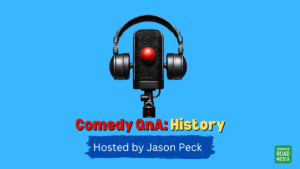I’m pleased and excited to announce that this week I have a guest author here at ProHumorist.com. Angela DeFinis is an author, speaker and consultant. More biographical information appears at the end of this article. Take it away Angela…
You show up to your speaking engagement only to realize that your PowerPoint presentation isn’t opening, the A/V system is down, and there’s a car alarm blaring right outside the window. There’s a full room of people eagerly waiting for you to begin and there is no turning back now. So what are you going to do?
Situations like this one happen all too often, and they require quick thinking and creative problem solving with little or no guidance. Improvisation is a must-have tool in the public speaker’s repertoire. Without it, speakers often find themselves in what I call “The Big Freeze”—that paralyzing moment of fear, physical immobility and mental shut down that leaves them unable to act. But if speakers utilize the teachings and techniques of improv, they can learn to overcome this fear and actually enjoy flying by the seat of their pants.
In his book Blink, author Malcom Gladwell explains that improv requires split-second, spontaneous decisions and hours of highly repetitive, structured practice. Think of a play in basketball. The players on the court all have defined positions, and they’ve spent hours practicing in order to execute properly. But often the play breaks down. Maybe the defense switched a match-up or there is an injury.
Do they just stand there, paralyzed? Of course not! Now the play becomes an adaptation. Because they’ve practiced so much, they’ve experienced the variables and can alter the play. The point-guard thinks on his toes, makes an extra pass, and the team ends up with a jump shot instead of a layup. As Gladwell puts it, “How good people’s decisions are [made] under the fast-moving, high-stress conditions of rapid cognition is a function of training and rules and rehearsal.”
The paramount improv rule, according to Gladwell, is the notion of agreement. As you can see in the video above, the comedians accept everything that comes their way. The key to their hilarity is the speed at which they “go with the flow.” There is a full commitment to agreement. All of a sudden, the issues that would normally hold a situation hostage due to incompatibility are accepted and incorporated. The answer is always “yes.” Gladwell notes, “Bad improvisers block action…Good improvisers develop action.”
So envision yourself as a basketball team or comedy troupe of one. When you find yourself presented with a public speaking distraction, limitation or challenge, think of it as just one more tool to make your presentation stand out.
With these lessons in mind, what would you do if the PowerPoint is down for the count, the microphone is on the fritz, and the Jeep outside your window just won’t quit?
Thanks a lot Angela for a great and thought-provoking article. If you want to swot up on improvisation there’s a good little book by the co-founder of iO (formerly ImprovOlympic) which is based in Chicago. The book’s called: Truth in Comedy: The Manual of Improvisation
About the Guest Author: Angela DeFinis is an industry expert in professional public speaking. As an author, speaker, consultant, and founder of DeFinis Communications, she has spent over twenty years helping business professionals communicate with greater poise, power, and passion. Angela reveals her coaching secrets in a chapter in the compendium, Roadmap to Success, published in the fall of 2008. Check out her DeFinis Communications blog and her main site DeFinis Communications.
Note: There are affiliate links on this page. That means if you make a purchase via my link, I get paid a commission. It helps me pay the bills.



